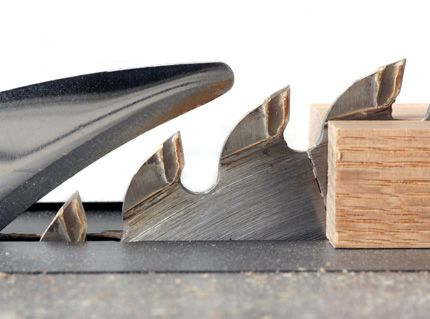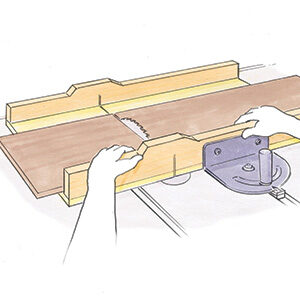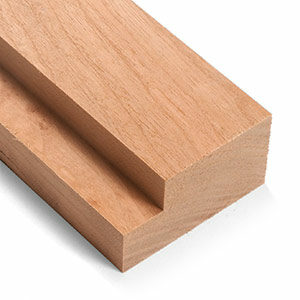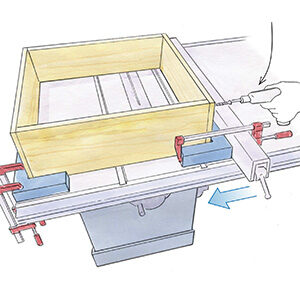
This week on Shop Talk Live, we catch an update on a tablesaw injury brought to our attention on a previous show. Was this woodworker's medical treatment akin to a miracle cure? Plus, back cover editor Jon Binzen on some of the best craftsmen in the business!
Shop Talk Live 57: Tablesaw Accident Update
![]()
This week on Shop Talk Live, we get an update on a tablesaw injury allegedly involving a riving knife and learn of a potentially useful medical treatment that every woodworker ought to know about. Is this regenerative wound treatment a potential game-changer when it comes to the deep and serious wounds sometimes suffered by woodworkers? Then, questions for this week inculded steam bending vs. bent lamination, paste wax in your finishing regimen, dealing with pesky glue lines, and more!
Plus, we sit down with Fine Woodworking back cover king Jon Binzen to find out how he picks the artists that grace the magazine’s back end, as wel as a few of his own woodworking road stories.
Links from this Week’s Show
A-Cell Regenerative Medicine Technology
Every two weeks, a team of Fine Woodworking staffers answer questions from readers on Shop Talk Live, Fine Woodworking’s biweekly podcast. Send your woodworking questions to shoptalk@taunton.com for consideration in the regular broadcast!
Click on the link at left to listen to the podcast, or catch it in iTunes. Remember, our continued existence relies upon listener support. So if you enjoy the show, be sure to leave us a five-star rating and maybe even a nice comment on our iTunes page. And don’t forget to send in your woodworking questions to shoptalk@taunton.com.






















Comments
Regarding bubbles in epoxy filler. We use 2 part epoxy to seal some assemblies building rockets. Our process puts the mixed sealant in a vacuum for 10 to 20 minutes and the air bubbles come right out. Of course this requires you to have a vacuum set up and the epoxy has to have a long enough set up time to allow the bubbles to migrate to the surface and still be workable.
there is already a great cure in place, DON'T stick your fingers and arm's in the blade path you morons. BTW this site and all others should SCREAM SAFETY FIRST PRACTICES not iffy CURES
I'm very upset with all of you for your failure to discuss saw safety in a serious way. In the earlier podcast you almost sounded like you were ridiculing the person injured. Even here, with more facts, it didn't sound as though you took this injury as seriously as you should have. And in an earlier podcast one of you imply that a riving knife solves table saw safety problems. But if you review the accident discussed here, a riving knife wouldn't or didn't help.
I think there are two elephants in the room. First, you all are in a state of denial. You're like soldiers thinking "it will never happen to me!" Or with hubris "I know better." And yet we are all human. We are not perfect. Some day....but then it will be too late.
Secondly, for probably political and financial reasons, Fine Woodworking refuses to discuss SawStop technology and value from a safety perspective. You seem to be avoiding mentioning SawStop. I understand how everyone hates being forced by regulations and a patent to purchase their technology. But you guys love new technology. Listen to your podcast of you drooling over the Veritas factory and their products. I often see SawStop saws being used in your videos and articles. Mark Adam's videos on saw safety focused on techniques while using a Sawstop saw. He never once mentioned their blade stop technology but did say, while pointing to a SawStop saw, "Today's saws are much safer with their new riving knives and streamlined guard systems." Shouldn't technology and techniques go hand and hand to improve safety? Why do you seem to skip over one of the greatest advancement in safety and only discuss riving knives? What am I missing?
Lastly, the FWW Feb. 2012 article "Tablesaw under Siege" ended with FWW stating it would respond to the CPSC's proposed rule and that "our editors and experts can shed valuable light on the real world implications of tablesaw safety gear..." Can you share these implications with your readers?
Jim Koren
Update:
This morning while hiking with my dogs, I was listening to the earlier podcasts that I missed and found that in STL 5 you did discuss the SawStop technology. So thank you for that.
Hey Jim, Thanks for writing. We may not take ourselves very seriously at times, but we all realize that safety is a very important issue. We had some fun at Billy's expense, but our thoughts go out to him along with wishes for a speedy recovery.
As far as the sawstop tablesaw goes, I think that the staff is in agreement that its a huge advancement in tablesaw safety. We have one in the shop and more and more of our authors are replacing their old saws with sawstop saws. Every school I teach at has them and it certainly reduces my stress!
I think some of the confusion stems from not only wanting to minimize the injury due to hand to blade contact, but also minimizing the risk of contact in the first place. That's where a riving knife is an important safety feature. It's my understanding that most hand to blade contact is due to stock contacting teeth at the rear of the blade. When that happens the stock is spun forward at lightning speed, often bringing the feeding hand, which is now past the blade, back across the blade. It's one of those instances where everything is going right until it goes horribly wrong. And you're absolutely correct that those of us who haven't experienced kickback yet probably take the threat too lightly.
The riving knife does do a really good job of preventing the type of kickback that often leads to serious injury, so it's often praised independent of the blade break technology.
I just added a splitter to the the insert in my old tablesaw this morning, but in a perfect world, I'd be using a saw with both a riving knife and blade brake technology.
Thanks for setting us straight! Mike
Our injured colleague gives you accurate information regarding the efficacy of A-cell therapy. There are several new skin cell therapies currently being used with many types of injuries from diabetic wound healing to traumatic laceration injuries from MVAs (motor vehicle accidents) and ither industrial injuries. These can and do take place in woodworking shops large, small, fancy and/or DIYers!
I am no physician. I minister as a Clinical Chaplain with Baptist Health, a regional healthcare system serving central and south Alabama. One of our physicians heads up our wounds therapy clinic. Serving as chairperson of our Institutional Review Committee for human participation in research, I know of this doctor's research work within the wound therapy field,as well.
Dr. Terry Treadwell of Montgomery,AL is on the front lines of the use of many of these therapies. He is the official United Nations physician appointed as head of developing healing strategies for our third world peoples. What you will learn from him, should you ask him what to use if you ctr your finger badly while whittling in the equatorian jungles of Borneo and find yourself without proper antimicrobials, bandages and tape, is that the universal healers of clean water and honey wrapped with palm leaves will begin good wound healing.
Yes, I am a woodworker of sorts. No expert! Woodworking is my joy of heart and solace therapy. Afterall, Jesus began in a carpenter's shop. I have had my own excitement with table saw kickback splinters from black walnut that were removed, yet one year later produced osteomylitis middle finger surgery for infection cleanout. What fun being the "chaplain" going to surgery with a "Bird Finger" the size of a brautwurst!
Smiles of Grace Guy,
Larry Davidson
A big thank you to JimKoren for pointing out the second elephant in the room. Unfortunately, the responses, or lack thereof, from the FWW editorial staff continue to disappoint on this issue. I too challenged FWW back in 2011, pointing out FWW's one-sided coverage of the CPSC investigation and subsequent report and the lack of journalistic engagement with PTI (Power Tool Institute) and their role in fostering the CPSC's actions. As I stated then:
"We still haven't seen an interview with PTI representatives or a single story/blog featuring the power tool industry's role in all of this. We do, however, have the other three constituents [CPSC, the Osorio court case, and Steve Gass] covered quite well."
I then listed the eight FWW articles/blog posts, which at the time--as far as I can tell--covered the entire editorial commitment to this issue, either online or in print, and not a single one covered PTI in any fashion. We were, however, given promises of a sort. On October 9th, 2011, Asa Christiana stated the following:
"Lots of interviewing still to do. My goal with these blogs was to ask the tough questions. You can be sure I'll be just as tough on PTI. That's a different blog, coming soon."
Tom McKenna also indicated on February 28th, 2012, that he was "trying to get more info about PTI's request" for the deadline extension, which many wrongly assumed was an underhanded tactic coming from the SawStop crowd.
It's been over two years now, and we still haven't seen a single PTI interview or PTI story let alone one that covers their role in bringing about the CPSC's actions. By any other journalistic standards, this would be a significant story, but nobody has bothered to pursue it. Why? If PTI has refused comment, as is the industry standard, that doesn't explain or excuse the lack of coverage on that front.
Finally, I very much appreciate Mike Pekovich's response in his attempt to navigate this issue in a way that doesn't offend the majority of FWW subscribers or the power tool industry while at the same time taking JimKoren's concerns seriously. As always, Mike did a great job in that respect. I find It almost impossible to be disappointed in anything Mike offers on FWW or elsewhere. Mike's knowledge, integrity, and passion for what he does commands respect for good reason. Nevertheless, I think his response demonstrates what seems to be an overriding financial and political set of interests at play here, and that sort of caution is deeply disappointing.
Respectfully
When I was a freshly minted Lieutenant Junior Grade, I was briefly assigned to the engine room of of the USS America (CV66) which made Dante's Inferno seem like a pleasant working environment. The only difference that I could discern was that Dante's Inferno probably had a lot less grease and oil,
I must have appeared to be absolutely scared out of my mind. As I was getting adjusted to the balmy 120 degree working environment, as well as the deafening noise that is created by the machinery that is necessary to propel an aircraft carrier, I became aware of the tremendous number of unguarded spinning shafts and cogs the size of my car, which could crush a Saw Stop without missing a beat which I was required to get much closer to than I really wanted too. Fortunately for me a wise Chief perceived my distress and concern about being sucked into the machinery and being spit out in a liquefied form and said "Sir, you'll be fine if you just remember the one safety rule that I tell everyone when they come down here...don't put your fingers anywhere you wouldn't put your you know what..."
All though its been 30 years since that Chief gave me those words of wisdom, I'm constantly grateful that he did as they have probably saved my fingers and thumbs countless times from doing something dangerous in the shop, on my boat or around the house. I hope that someone takes this wise Chief's advice and that it gives them a new frame of reference that allows them to work in a safer manner. I only wish that I could remember the Chief's name so that I could thank him ,
W, Robb Graham
Being the Billy with said injury I assure you I took no offense what so ever. Thanks for well wishes.
Being the Billy with said injury I assure you I took no offense what so ever. Thanks for well wishes.
I disagree with the comment about carbide tipped bandsaw blades breaking before the teeth wear out. The teeth on my Laguna Resaw King 1" blades (2) are placed so the bands bending effect on the teeth is minimal if not non existent. I have had the blades sharpened as needed with no teeth needing to be replaced or any comment back from Laguna about any work being done other than sharpening. This is a 14" bandsaw which is the most common size and doesn't appear to put any extra strain on the carbide blade.
Love the show but, this comment seemed to be thought about but not experienced. The Resaw King blades do a remarkable job and last much longer than any previous blades I've used.
Ken Willingham, Newburgh Indiana
Last year about this time I sent this inquiry to the PTI. I was reading an article in Fine Woodworking magazine the other day that stated, “The PTI said 800,000 saws have been sold since 2007 that meet the updated voluntary standard (UL 987), which includes an improved blade-guard design and riving knife.” From Fine Woodworking #224 December 8, 2011. This is very good information, however is there some direct quantifiable charts or statistics supporting this data over a broader span of time, the last 25 years, for example of table saw sales in particular that I may survey? My purpose is to evaluate the market profile for a ancillary product of my design. Any assistance in this would be of great assistance. Sincerely, Joseph Warren........ their response was...
Joseph,
The Power Tool Institute does not have any publicly available information on the size of the table saw market over the past 25 years.
Sorry that we are unable to be of assistance. The roar of the crickets was deafening!!! I was not asking for proprietary trade secrets, just a good place to start the investigation for my intended market...since the were so free with the initial claim....I would have appreciated the last decade or so...
Mike, you will probably get the same response tone for your query. I love FWW.......joseph warren
Log in or create an account to post a comment.
Sign up Log in